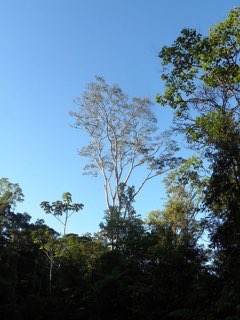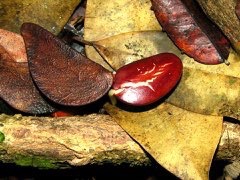 |
|
Reinaldo Aguilar flickr.com |
 |
| Reinaldo Aguilar flickr.com |
Translate this page:
Summary
One of the most valuable timbers of southern Costa Rica, Peltogyne purpurea or commonly known as Nazareno grows up to 40m in height, with an elongated crown. The bole that branches from low down is moderately buttressed and can be up to 100cm in diameter. It is commonly grown in Colombia, Panama, and Costa Rica. The leaves are pinnate and alternate. The flowers are white, small, aromatic, and forms into clusters. Fruits are brown containing single seed pods, and mature between November and February. The wood is very hard, heavy, tough, and strong. It is difficult to work and used for agricultural tools, boats, carpentry, construction, furniture, cabinet-making, flooring, veneer, and panelling among others.
Physical Characteristics

 Peltogyne purpurea is a deciduous Tree growing to 30 m (98ft) by 25 m (82ft) at a medium rate.
Peltogyne purpurea is a deciduous Tree growing to 30 m (98ft) by 25 m (82ft) at a medium rate.
See above for USDA hardiness. It is hardy to UK zone 10.
It can fix Nitrogen.
Suitable for: light (sandy), medium (loamy) and heavy (clay) soils and prefers well-drained soil. Suitable pH: mildly acid, neutral and basic (mildly alkaline) soils. It cannot grow in the shade. It prefers dry or moist soil.
UK Hardiness Map
US Hardiness Map
Synonyms
No synonyms are recorded for this name.
Plant Habitats
Edible Uses
References More on Edible Uses
Medicinal Uses
Plants For A Future can not take any responsibility for any adverse effects from the use of plants. Always seek advice from a professional before using a plant medicinally.
None known
References More on Medicinal Uses
The Bookshop: Edible Plant Books
Our Latest books on Perennial Plants For Food Forests and Permaculture Gardens in paperback or digital formats.

Edible Tropical Plants
Food Forest Plants for Hotter Conditions: 250+ Plants For Tropical Food Forests & Permaculture Gardens.
More

Edible Temperate Plants
Plants for Your Food Forest: 500 Plants for Temperate Food Forests & Permaculture Gardens.
More

More Books
PFAF have eight books available in paperback and digital formats. Browse the shop for more information.
Shop Now
Other Uses
Wood
Other Uses The heartwood is purple, streaked with darker or lighter shades of the same, drying to a brilliant purple when exposed to the light; the thick layer of sapwood is nearly white, drying to a gray-yellow-brown[381 , 551 ]. The wood is very hard, heavy, strong, tough, fine-grained and often cross-grained. It takes a very beautiful polish. It is difficult to split and work[381 , 551 ]. It has been used for agricultural tools, boats, general carpentry, interior and exterior construction, railway foundations, furniture, cabinetwork, panelling, inlays, flooring, dock fenders, veneer, and ornamental plates[381 ].
Special Uses
Nitrogen Fixer
References More on Other Uses
Cultivation details
A plant of the moist, lowland tropics, usually found in areas with a distinct dry season[409 ].
References Carbon Farming Information and Carbon Sequestration Information
Temperature Converter
Type a value in the Celsius field to convert the value to Fahrenheit:
Fahrenheit:
The PFAF Bookshop
Plants For A Future have a number of books available in paperback and digital form. Book titles include Edible Plants, Edible Perennials, Edible Trees,Edible Shrubs, Woodland Gardening, and Temperate Food Forest Plants. Our new book is Food Forest Plants For Hotter Conditions (Tropical and Sub-Tropical).
Shop Now
Plant Propagation
The fruits remain on the trees long after their maturation and the seeds, when freed by the opening of the valves, continue to adhere to the valves through the funicle, reaching the ground only, as it seems, when the condition are favourable to ensure germination[551 ].
Other Names
If available other names are mentioned here
Purpleheart, Amaranth, Nazareno
Native Range
SOUTHERN AMERICA: Costa Rica, Panama, Colombia
Weed Potential
Right plant wrong place. We are currently updating this section.
Please note that a plant may be invasive in one area but may not in your area so it's worth checking.
Conservation Status
IUCN Red List of Threatened Plants Status : This taxon has not yet been assessed

Growth: S = slow M = medium F = fast. Soil: L = light (sandy) M = medium H = heavy (clay). pH: A = acid N = neutral B = basic (alkaline). Shade: F = full shade S = semi-shade N = no shade. Moisture: D = dry M = Moist We = wet Wa = water.
Now available:
Food Forest Plants for Mediterranean Conditions
350+ Perennial Plants For Mediterranean and Drier Food Forests and Permaculture Gardens.
[Paperback and eBook]
This is the third in Plants For A Future's series of plant guides for food forests tailored to
specific climate zones. Following volumes on temperate and tropical ecosystems, this book focuses
on species suited to Mediterranean conditions—regions with hot, dry summers and cool, wet winters,
often facing the added challenge of climate change.
Read More
Expert comment
Author
Pittier
Botanical References
Links / References
For a list of references used on this page please go here
A special thanks to Ken Fern for some of the information used on this page.
Readers comment
| Add a comment |
|
If you have important information about this plant that may help other users please add a comment or link below. Only comments or links that are felt to be directly relevant to a plant will be included. If you think a comment/link or information contained on this page is inaccurate or misleading we would welcome your feedback at [email protected]. If you have questions about a plant please use the Forum on this website as we do not have the resources to answer questions ourselves.
* Please note: the comments by website users are not necessarily those held by PFAF and may give misleading or inaccurate information.
To leave a comment please Register or login here All comments need to be approved so will not appear immediately.
|
Subject : Peltogyne purpurea
|
|
|
|